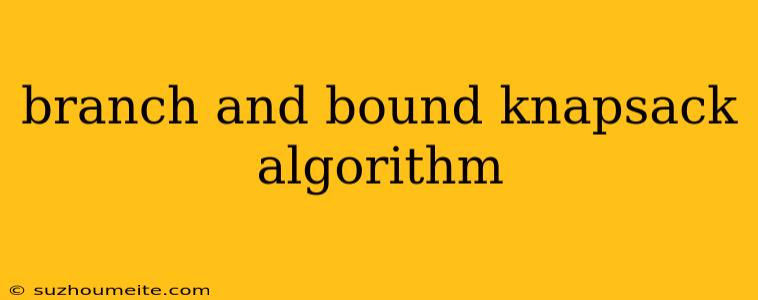Branch and Bound Knapsack Algorithm
The branch and bound algorithm is a general-purpose algorithm used to find the optimal solution to various combinatorial optimization problems. It works by systematically searching through the solution space while eliminating portions that cannot contain the optimal solution. In this article, we'll focus on how the branch and bound algorithm can be applied to solve the knapsack problem.
The Knapsack Problem
The knapsack problem is a classic optimization problem where you are given a set of items, each with a weight and value, and a knapsack with a maximum weight capacity. The goal is to select a subset of items that maximizes the total value while staying within the weight limit of the knapsack.
Branch and Bound Approach for the Knapsack Problem
The branch and bound algorithm tackles the knapsack problem by:
- Creating a decision tree: The algorithm starts by creating a decision tree where each node represents a potential solution. The root node represents the initial state with no items selected. Each branch represents the decision of adding or not adding a specific item to the knapsack.
- Bounding: At each node, the algorithm computes an upper bound on the total value that can be achieved by any solution that includes the items already selected in that node. This bound is usually calculated using a relaxed version of the problem, such as a fractional knapsack where you can take fractions of items.
- Branching: The algorithm then branches out from the current node, exploring both options: including the next item or excluding it.
- Pruning: If the upper bound of a node is less than the current best solution found so far, the subtree rooted at that node is pruned, as it cannot contain the optimal solution.
Algorithm Steps
Here's a step-by-step breakdown of the algorithm:
- Initialization:
- Initialize the current best solution with a value of 0.
- Create a queue to store the nodes to be explored.
- Add the root node to the queue.
- Iteration:
- While the queue is not empty:
- Remove a node from the queue.
- If the node represents a feasible solution (all items considered), update the current best solution if the node's value is higher.
- If the node is not a feasible solution:
- Calculate the upper bound for the node.
- If the upper bound is greater than the current best solution:
- Create two child nodes for the current node, one including the next item and the other excluding it.
- Add the child nodes to the queue.
- While the queue is not empty:
- Termination:
- The algorithm terminates when the queue becomes empty. The current best solution is the optimal solution to the knapsack problem.
Example
Let's consider a simple knapsack problem with the following items:
| Item | Weight | Value |
|---|---|---|
| A | 2 | 6 |
| B | 3 | 10 |
| C | 4 | 12 |
The knapsack capacity is 5.
- Initialization:
- Current best solution: 0.
- Queue: [root node]
- Iteration 1:
- Remove root node from the queue.
- Calculate upper bound for the root node: (using fractional knapsack, take 2.5 units of item C) = 15.
- Create two child nodes:
- Node 1: Include item A, upper bound = 12 (6 from item A + 6 from 2 units of item C).
- Node 2: Exclude item A, upper bound = 15.
- Update queue: [Node 1, Node 2].
- Iteration 2:
- Remove Node 1 from the queue.
- Calculate upper bound: (using fractional knapsack, take 1 unit of item B) = 16.
- Create two child nodes:
- Node 3: Include item B, upper bound = 16 (6 from item A + 10 from item B).
- Node 4: Exclude item B, upper bound = 12 (6 from item A + 6 from item C).
- Update queue: [Node 2, Node 3, Node 4].
- Continue this process until the queue is empty.
Advantages of Branch and Bound
- Optimal solution: It guarantees finding the best possible solution.
- Flexibility: Can handle complex constraints and objective functions.
- Efficiency: Pruning helps significantly reduce the search space.
Disadvantages of Branch and Bound
- Computational complexity: Can be computationally expensive for large problem instances.
- Implementation: Requires careful implementation to ensure efficient pruning and bound calculations.
Conclusion
The branch and bound algorithm offers a powerful approach to solving the knapsack problem and other optimization problems. While it involves a systematic search, its pruning mechanism makes it more efficient than a brute-force approach. By understanding the core principles of this algorithm, you can apply it to various scenarios where you need to find the best solution within a constrained environment.
